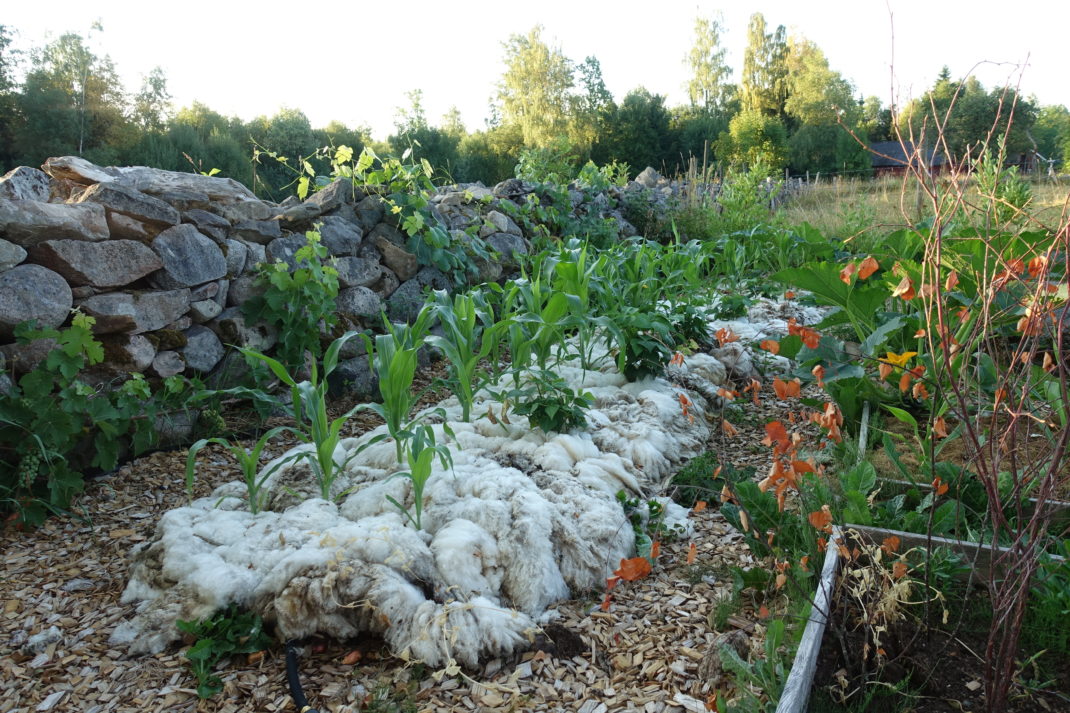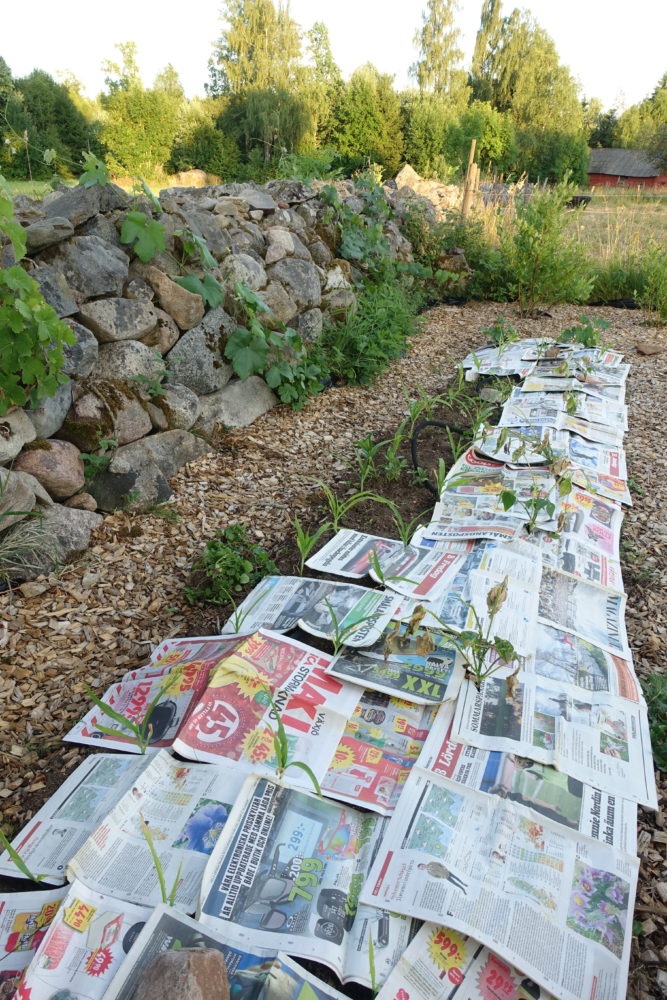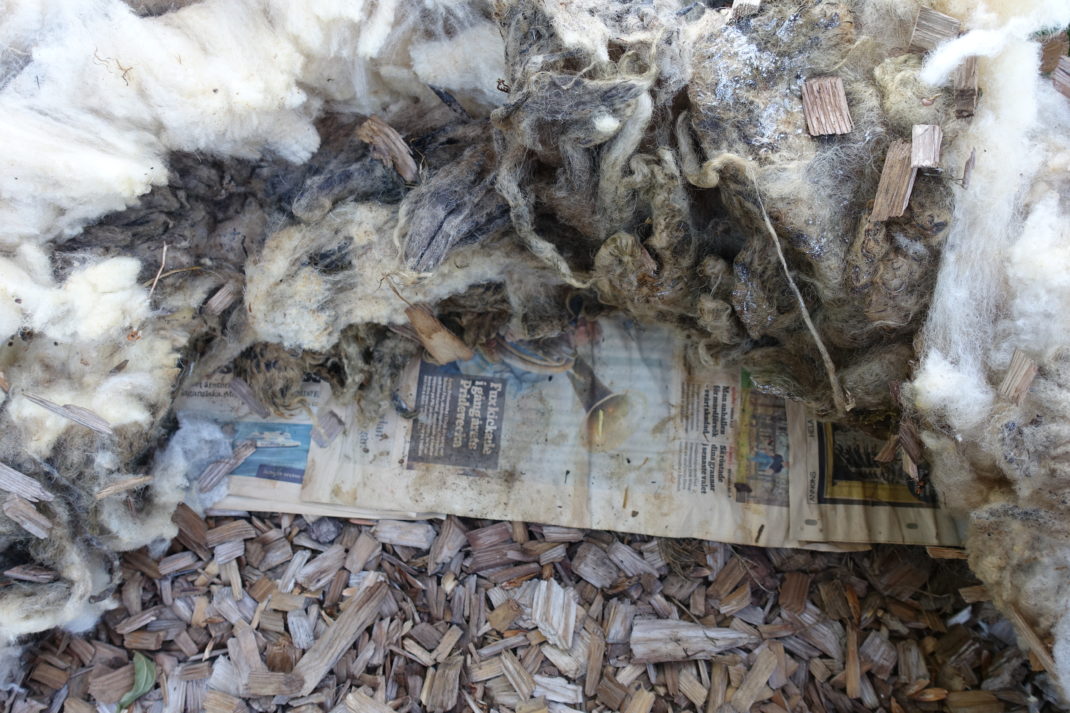Mulching with sheep's wool
I finally decided to try mulching with wool! This is what my first attempt looks like. I think it works really well, and it looks beautiful too!

My corn is thriving a few weeks after I covered the beds. Mulching with wool seems to work!
I'm a big fan of mulching, as you probably know by now, and I've had great results mulching with grass clippings, leaves, ensilage, straw, and assorted plant parts. Mulching is essential in my garden. It's the one main reason why I've been able to cultivate this whole area all by myself. I've never tried mulching with wool though. But there's a first time for everything, and today is the day!
It's really difficult to find good information about this method in Swedish. Many of the sources I've seen talk about how mulching with wool is beneficial, but I haven't really found any detailed descriptions about what the advantages actually are. The pictures I've seen mostly show wool that's been used for specific plants during a shorter time period. Those who swear by this method in a broader sense seem to think it's very effective though.
An unconventional method?
I was happy to learn that there was plenty of information about this perhaps unconventional mulch in English. For example, I managed to find detailed instructions about how to use a type of wool mat as mulch. Wool is supposed to keep the soil cool in summer and warm in the cold winter. It also prevents the soil from drying out, helps keep the weeds out and also adds nutrients to the soil. Just like the other mulching materials I use! Many of those who have tried this method also talk about having less problems with snails. The wool also keeps the deer away, which would be perfect for my cabbage patch.
I've heard that the wool lasts about two years before you need to replace it. So, let's try it out!

I watered the soil twice before I started to cover it. I put a layer of newspapers over my drip hose to keep weeds from growing here.

My bed looks so fluffy with all that wool! Kuling is keeping a close eye on it for me.

The little corn plants and my beans are barely visible under the thick layer of wool.
How it's done:
- I removed the weeds in the bed
- Put a drip irrigation hose on top of the soil.
- I then added newspapers on top of the hose to cover the soil between the plants.
- Finally, I put a thick layer of wool on top.
I needed about three large construction bags of wool for this project. The wool is completely untreated.
The wool helps keep the soil moist
The wool has been on top of the soil for a few weeks now and my corn has been growing really nicely in the bed since. I've been lifting the wool up and felt the soil from time to time, and it's nice and moist! I've used my drip irrigation system two times so far, watering the beds for about 20 minutes each time. This is a deep bed and my guess is that it will have stored a lot of water even though I don't water very much in general. This is just what I need! I also watered each plant in the bed with nettle water once to add some extra nutrients.
Mulching with wool in the cabbage patch
I see a lot of potential in this method, if I can find a hassle-free way of doing it. A lot of sheep owners have excess wool that they simply don't need, so it shouldn't be that difficult to find the material. It might be a bit of a challenge to transport it though.
I have four separate quarters in my garden, and I rotate my crops. I have four main crops that I alternate in different quarters every year. From how it looks now, I might just start mulching my cabbage patch in spring or fall. Then, I'll plant pre-cultivated cabbage plants by simply cutting a hole in the wool or moving it to the side so I can reach the soil. Tomatoes, corn, gourds and some beans and other plants would work too.
It might be more difficult to do mulching with wool in the beds where I'm planning to direct-sow vegetables, for example carrots and parsnips. I might need to experiment a bit more here.
The plan is to mulch the beds outside, but I also want to cover my raised pallet collar beds and the polytunnels. The soil analysis I did (you can read more about that here on Sara's Kitchen Garden) showed that mulching would do wonders for the soil in my polytunnels. Mulching with wool might just be the way!

My corn and beans are thriving in the bed I mulched with wool. The plants were not very healthy when I planted them but they look so nice now.
How to edge the garden beds
Many of you who follow Sara's Kitchen Garden want to know how I make the edges to my garden beds, especially where I cover the paths with wood chips.
The landscape fabric is edge to edge with the soil in my bed, with a layer of wood chips on top. Some soil might fall down on the path when you rake the beds, but it's easy to remove. I'll show you what the beds look like with the wool on top below. Treat the wool like any other kind of mulch, use the same methods as you usually do.

This is what the bed looks like next to the path I covered with wood chips.

I put a layer of newspapers underneath the wool. The wool reaches an inch or so outside the layer of newspapers.

The soil underneath the newspaper is nice and moist. The newspapers overlap the wood chip path a little bit, so the bed might look a little wider than it actually is. There are no weeds at all here, surprisingly enough!
I feel really excited about this project! I cover the ground bit by bit and I look forward to see the fruits of my labor. Mulching with wool seems to work really well already, the vegetables are growing nicely. And I actually think it looks really beautiful too. I hope this method will prove to be useful, so that I can start doing it regularly.
Leave a comment if you tried mulching with wool too!
/Sara Bäckmo
04. September 2021



Leave a Reply
You must be logged in to post a comment.